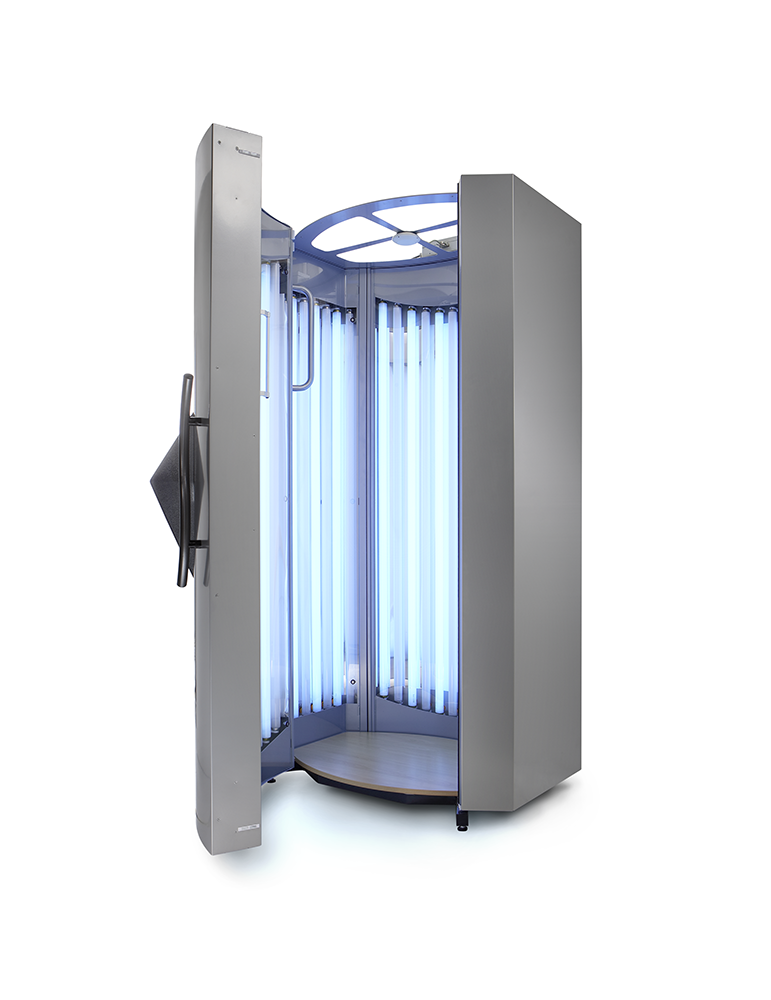Last updated: October 2023
What is phototherapy?
Phototherapy uses different wavelengths of ultraviolet (UV) light on the surface and in deeper layers of the skin. Phototherapy can treat widespread skin diseases, as well as conditions that cause loss of colour.
When is phototherapy used?
Phototherapy is commonly used to treat widespread skin conditions, such as atopic dermatitis (eczema) and psoriasis that cause inflammation (redness, scaling, itching, tenderness and swelling). It may be used to treat vitiligo, but it may take longer for the skin to respond to the treatment and recovery may only be partial.
Phototherapy may also be used to treat less common conditions, such as lichen planus, granuloma annulare and mycosis fungoides.
What types of ultraviolet treatments are there?
Ultraviolet B (UVB)
Ultraviolet B (UVB) phototherapy delivers shortwave UV to treat skin conditions, such as psoriasis and eczema by controlling DNA synthesis. This reduces inflammation.
Narrowband UVB (NBUVB) phototherapy is used more than broadband UVB phototherapy. Exposure and treatment times are shorter for NBUVB and result in longer periods of remission.
Psoralen + UVA (PUVA)
Psoralen + UVA (PUVA) is another type of phototherapy treatment used for severe skin diseases.
PUVA is a combination treatment which involves psoralen medication and exposing the skin to a longer wavelength of ultraviolet light which can penetrate more deeply into the skin.
What will I have to do if phototherapy is prescribed for me?
Individuals should advise their dermatologist about any medications that are being taken when phototherapy is first prescribed.
Before phototherapy treatment, the dermatologist will provide protective eyewear to cover the eyes. In some cases, individuals may be given additional protective equipment, such as a facemask, depending on the location of the treatment. Individuals will need to stand still inside the phototherapy cabinet which has fluorescent tubes that produce ultraviolet rays on the walls. Each treatment session will last from several seconds to several minutes. The treatment can be stopped at any stage by opening the door of the cabinet and stepping out.
The dermatologist will determine the dosage by testing the response of a small area of non-sun-exposed skin to a series of ultraviolet doses, or by evaluating the individuals skin type (fair, olive, dark, very dark). A protocol is then developed and followed based on this assessment.
Treatment usually occurs three times per week (evenly spaced throughout the week) for up to 10 weeks. However, this may be adjusted by the dermatologist.
It is important individuals attend appointments regularly to achieve the best possible outcome.

Figure 1. Phototherapy Full Body Cabin
When is phototherapy not used?
Phototherapy may not be recommended for individuals who:
- Have difficulties standing for periods of time.
- Are unable to attend regular treatment sessions.
- Have a history of melanoma. For other types of skin cancer, UV therapy should only be undertaken with caution and close monitoring.
- Have “sun sensitive” disorders (g., lupus or porphyria), or hereditary conditions (e.g., xeroderma pigmentosum).
- May not be able to tolerate being in the confined space within the phototherapy cabinet.
What problems can occur with phototherapy?
There are potential risks that can occur with phototherapy, including:
- Dry skin
- Skin redness, burns or blisters, similar to a sunburn
- Increased wrinkles and skin laxity (looseness), and colour changes to the skin with prolonged treatment
- Development of skin cancer with prolonged treatment
What is the likely outcome of phototherapy?
Phototherapy treatment will usually be continued until the skin condition has cleared or is stable. In some cases, the frequency of treatments may be reduced rather than stopped. Any ongoing treatment and management should be under the supervision of the individual’s dermatologist.
| Dr Daniel Hewitt | October 2023 |
| Dr Daniel Hewitt | October 2014 |
Disclaimer
2019 © Australasian College of Dermatologists.
You may use for personal use only. Please refer to our disclaimer.